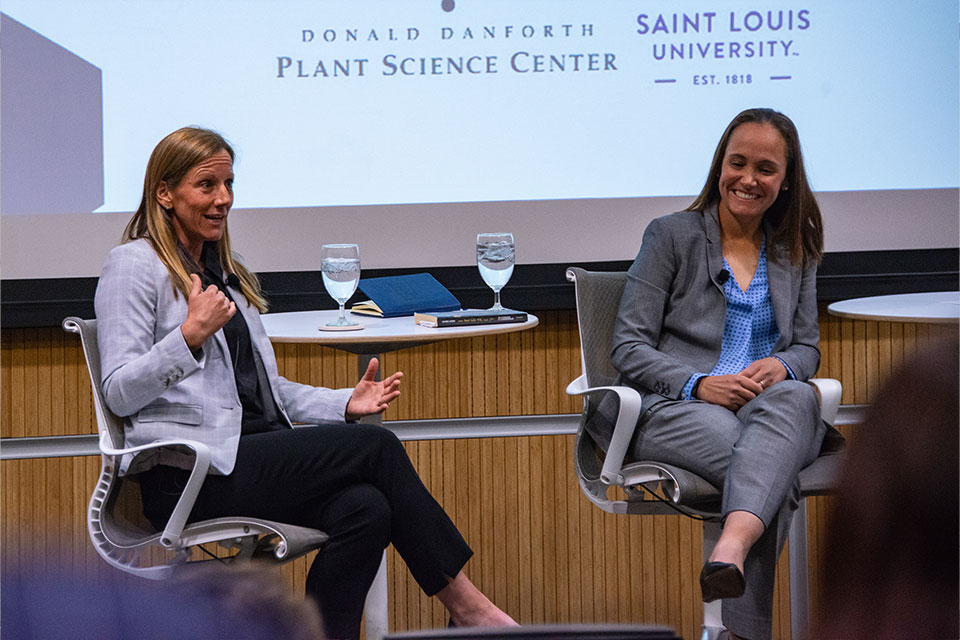SLU Coach, Professor Share Insights on Getting the Best Out of Your Team
Culture is tough to define, but you know it when you see it. Defining culture and determining how to use it to make teams successful was the goal for “Leading Teams on the Field and in Science,” a panel discussion with Allison Miller, Ph.D., professor of biology at Saint Louis University and principal investigator at the Danforth Plant Science Center, and Katie Shields, head women’s soccer coach at SLU. For more than an hour, Shields and Miller traded insights on how they have made their respective teams successful, shared tactics to build culture and more.
A theme throughout the discussion was building and maintaining culture, even when
teams have significant turnover. In collegiate soccer, approximately 25 percent of
a roster turns over every season due to graduations and transfers. Meanwhile, in science,
many colleagues only work together on a single project before moving on to new colleagues
and projects. Getting buy-ins from everyone, even when teammates change quickly, is
vital to maintaining success.
“One of the differences between sports and science is that us scientists are all parts of many teams,” Miller said. “I’m a part of my lab team, and I’m part of multiple different project teams and different institutions and departments. And they’re all different, and they all have different missions.”
In the context of these challenges, how can teams develop and sustain shared values?
Shields discussed how team members can create a mission statement to point back to that describes who they are, what they want to be and how they will get there. But team leaders can’t be the ones who create those statements; they need to be developed by the team itself.
“We felt it was important when we started to build this modern soccer program that our mission statement was chosen and written by the women of the program,” Shields said. “Yes, I am the coach, but it’s really the women who wear the jersey and who make the program. We talk about equal ownership within our program, that everyone has the same ownership as each other. Being a part of creating that mission creates equal ownership. The best teams are the ones who have a clarity of mission and then bring those values off the paper, off the walls and to life.”
One of the ways women’s soccer brings its mission to life is by everyone on the team reading the same book, James Kerr’s Legacy: 15 Lessons in Leadership, about New Zealand’s national rugby team, the most successful professional sports franchise in history.
“We started to give the book to every incoming freshman, and then it evolved to where a copy gets passed down from a graduating senior to an incoming freshman,” Shields said. “It’s been loved, it’s been tabbed, and it becomes this cultural touchpoint. It’s been really helpful for a turnover standpoint to help sustain identity and culture.”
Incoming freshmen also talk with former players who wore the same number to hear about their experiences while competing for SLU. It’s a connection that helps new student-athletes appreciate that they are part of something than themselves.
“It’s this idea that wherever you enter our program, whatever you do, it’s your responsibility to come in and leave the jersey in a better place,” Shields said. “If you don’t care about the women who came before you, how can you care about the women who will come after you?”
For Miller, the notion of continuous learning and growth is also essential.
One of the values we identified was ‘growth mindset,’ which is the idea that nothing is fixed in time, that everyone and everything is possible of growth," Miller said. "Everybody works together to achieve a common goal, and that brings people together. That’s something we’ve found has worked well recently.”
Shields and Miller concurred that on the field and in the lab, their teams shared a core motivation: to leave wherever they are a better place than where they found it. For SLU women’s soccer, that’s called leaving the jersey in a better place -- making the program better than when you joined, for everyone, regardless of wins and losses. And in science, the goal is to leave the world in a better place.
If there was one idea both Shields and Miller wanted the audience to leave the Leading Teams event with, it was that regardless of what team you were a part of, success requires selfless effort from everyone involved, and together, each person can leave their mark on the world.
“Excellence does not happen in isolation,” SLU President Fred P. Pestello, Ph.D., said in his closing remarks. “Excellence requires community. It requires dialog. A drive to collaboratively pursue important questions and go wherever they take you. It requires insights and experiences from multiple disciplines, expertise, perspectives and institutions. It requires teams that bring out the best in all of us. And it requires leaders like Katie and Allison, who are goal-driven, people-centered and aspire to greatness.”


















